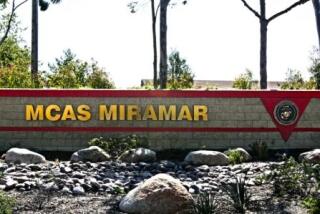F-14A Tomcat Considered About Average for Safety
- Share via
The F-14A Tomcat, a sophisticated two-seat jet introduced in 1972, is the Navy’s front-line fighter plane.
Taking off from aircraft carriers, the planes are used in aerial dogfights and are designed to protect carrier groups from enemy aircraft. They can fly at twice the speed of sound and track and destroy targets up to 100 miles away.
Their pilots must be highly skilled, capable of performing high-speed aerial maneuvers as well as hair-raising night landings on the dark decks of bobbing carriers.
Monday marked the 96th and 97th crashes of the $33.5-million plane. An hour before the El Cajon crash, another F-14 crashed into the Atlantic and sank 40 miles east of Oregon Inlet, N.C.
The Navy now has 480 F-14s in service, nearly all of which are F-14As. Some F-14A-Plus jets, with more powerful engines, have recently gone into service, and a new and redesigned F-14D is in production.
Despite the 97 crashes, the F-14 is not considered a particularly problematic plane, according to Navy spokesmen and a staff member of the House Armed Services Committee, who asked that his name not be used.
“It’s a middle-of-the-pack performer,” the staff member said. “It’s not considered to be inherently safe or unsafe.”
“We’re talking about a very high-performance aircraft, and the training associated with it--the ‘Top Gun’ school at Miramar--is very stressful.
“That’s not to say it (the jet) hasn’t had its problems over the years. It has, but all within the bounds of what one would expect.”
In the jet’s early days of operation, pilots had problems with engine stall when the F-14 reached certain angles, the staff member said. The problem was attributed to the fact that when the body of the plane was designed, no new engine was designed to go with it, he said. Instead, existing engines were used.
It was later discovered that the configuration of the plane and the engine air requirements were incompatible when the Tomcat was flying at certain angles. Because of the flaw, air flow to the engines could be cut off, sending the plane into a spin and crash.
When the problem was discovered, pilots were instructed to fly within the limitations of the engines, the staff member said.
The problem apparently has been corrected in the newer F-14A-Plus jets, as well as the F-14Ds under construction.
More to Read
Inside the business of entertainment
The Wide Shot brings you news, analysis and insights on everything from streaming wars to production — and what it all means for the future.
You may occasionally receive promotional content from the Los Angeles Times.










